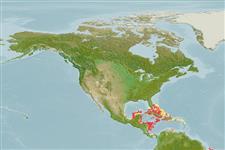Klassifizierung / Names
Namen | Synonyme | Catalog of Fishes(Gattung, Arten) | ITIS | CoL | WoRMS | Cloffa
>
Gobiiformes (Gobies) >
Gobiidae (Gobies) > Gobiinae
Etymology: Evermannichthys: From Evermann, 1902, researcher about fauna + greek, ichthys = fish (Ref. 45335).
Eponymy: Dr Barton Warren Evermann (1853–1932) was a schoolteacher (1876–1886) and a student at Indiana University, where he was awarded his bachelor’s degree (1886), master’s (1888) and doctorate (1891). [...] (Ref. 128868), visit book page.
Environment: milieu / climate zone / depth range / distribution range
Ökologie
seewasser demersal; tiefenbereich 27 - 30 m (Ref. 40966). Tropical
Western Central Atlantic: known from the type locality, Navassa Island. Also from the Bahamas (Ref. 92840).
Size / Gewicht / Alter
Maturity: Lm ? range ? - ? cm
Max length : 3.0 cm SL Männchen/unbestimmt; (Ref. 92840)
Kurzbeschreibung
Bestimmungsschlüssel | Morphologie | Morphometrie
Rückenflossenstacheln (insgesamt) : 6 - 7; Rückenflossenweichstrahlen (insgesamt) : 10; Afterflossenweichstrahlen: 9. Distinguished by having the following characteristics: thin and elongate in form; reduced scale cover and head pores; depth of body about 2 mm (Ref. 92840); uniformly dark on dorsal third of body and pale on remainder; clear median and paired fins; frenum connecting the upper lip to snout is reduced; separated upper lip and snout; tongue is emarginate (Ref. 44822).
Obligate sponge dwellers. Live deep within canals of the sponges, near the openings to the incurrent canals. Sponges provide species with protection from predators and an available food source in many invertebrates. Eggs found within sponge or small plankton brought through incurrent pores (Ref. 92840).
Life cycle and mating behavior
Geschlechtsreife | Fortpflanzung | Ablaichen | Eier | Fecundity | Larven
Eschmeyer, W.N. (ed.), 2001. Catalog of fishes. Updated database version of December 2001. Catalog databases as made available to FishBase in December 2001. (Ref. 40966)
IUCN Rote Liste Status (Ref. 130435: Version 2024-2)
Bedrohung für Menschen
Harmless
Nutzung durch Menschen
Tools
Zusatzinformationen
Download XML
Internet Quellen
Estimates based on models
Preferred temperature (Ref.
123201): 21.2 - 27.7, mean 26.5 °C (based on 42 cells).
Phylogenetic diversity index (Ref.
82804): PD
50 = 0.5312 [Uniqueness, from 0.5 = low to 2.0 = high].
Bayesian length-weight: a=0.00724 (0.00339 - 0.01546), b=3.10 (2.92 - 3.28), in cm total length, based on LWR estimates for this (Sub)family-body shape (Ref.
93245).
Trophic level (Ref.
69278): 3.1 ±0.3 se; based on size and trophs of closest relatives
Widerstandsfähigkeit (Ref.
120179): hoch, Verdopplung der Population dauert weniger als 15 Monate. (Preliminary K or Fecundity.).
Fishing Vulnerability (Ref.
59153): Low vulnerability (10 of 100).
